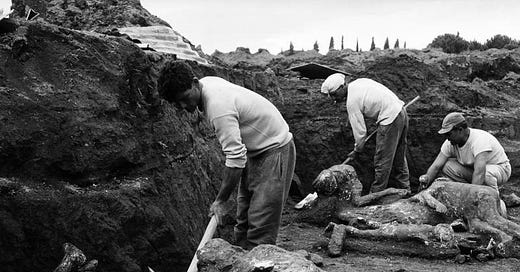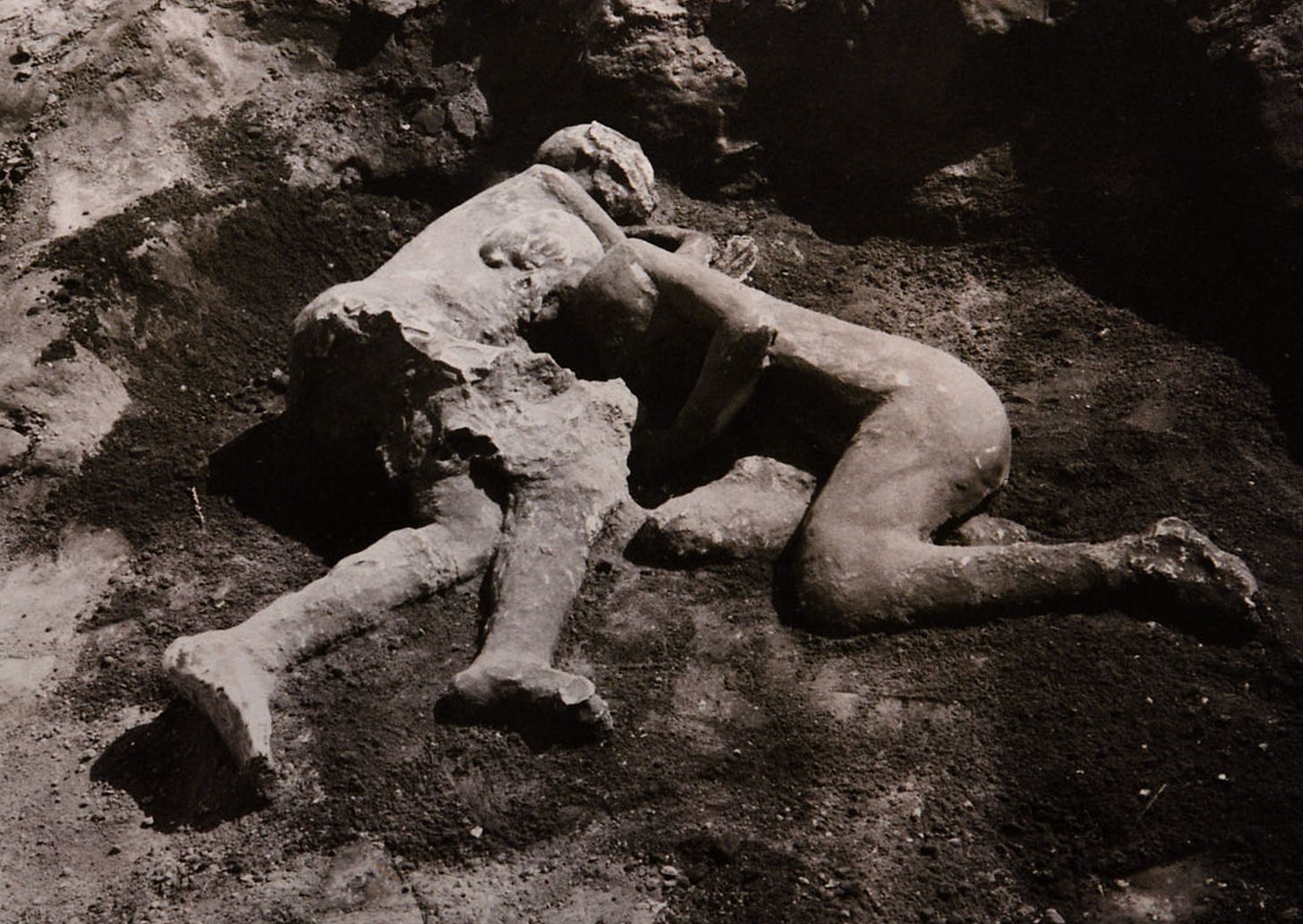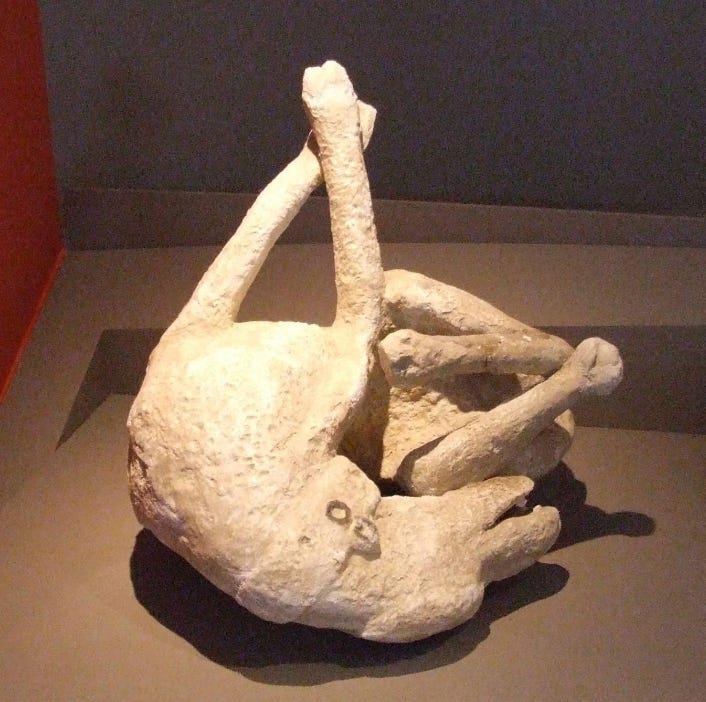As I wandered the ancient ruins of Pompeii, I felt the air thicken with something more than the weight of history. It was as if the souls of the city—those frozen in their last moments—were reaching out, offering whispers of their lives long past. Unlike the peaceful stillness of death masks, these figures stand at the edge of life itself, frozen when they face the unthinkable. And yet, in their silence, they invite us to imagine their lives before that fateful day in 79 AD.
What if we could walk with them?
What if each frozen soul guided us, showing us the Pompeii they knew before the sky darkened and the ash fell? It is not just a tour of the city’s ruins but of a city alive, vibrant, and full of humanity. Each soul has a story to tell and a life to share; through them, Pompeii rises again.
The Wailing Woman: A Mother’s Final Prayer
As I came upon the figure of the Wailing Woman, her hands raised to shield her face, I felt her story unfold around me. She was a mother, perhaps hurrying home after buying vegetables from the market. The forum was bustling, filled with merchants hawking goods and children laughing as they ran between the stalls. She smiled at the baker, a kind old man who always saved the freshest loaves for her family. But now, standing in the ruins, I see her fear—her hands raised not in greeting but in a desperate plea, perhaps praying to the gods for deliverance.
At this moment, she becomes my guide, showing me Pompeii, where her children waited for her to return, their small faces lighting up when she walked through the door. Her voice whispers through the ancient streets, reminding me of the ordinary beauty in everyday life—the meals prepared with love, the laughter shared over simple moments, and the deep instinct to protect those we hold dear. And then, her hands fall silent again, raised eternally in a gesture of hope and fear. She shows us that, even in the face of death, a mother’s love lingers, frozen but still powerful, still present.
The Lovers of Pompeii: An Eternal Embrace
Further down the path, I encounter the Lovers of Pompeii, entwined in their final embrace. Their frozen forms, so often romanticized, speak of more than love—they talk about a connection that transcends even death. As I pause before them, the bustling city comes alive once more, and they lead me through their story. Perhaps they were newlyweds, standing together in the atrium of their modest home. He would have been a craftsman, working with clay or stone, and she, a seamstress or a merchant’s daughter, helping to manage the household. Together, they dreamed of a future—of children, prosperity, and love that would carry them through old age.
As we walked, they showed me the Pompeii they once knew: the baths where they would relax in the warm evenings, the quiet garden where they shared meals beneath the olive trees. But as they guide me deeper into the ruins, I see that their final moment together was not despair but unity. When the sky darkened and the earth trembled, they held onto one another, not just for comfort but as a testament to their bond—a bond that would remain unbroken even as their world fell to ashes. Now, frozen in their embrace, they invite us to witness the eternal power of love—love that defies time, disaster, and even death itself.
The Runner: A Final Attempt at Escape
Not far from the lovers, I come across the figure of the Runner, caught mid-stride, fleeing the terror descending upon Pompeii. His posture speaks of urgency, a primal instinct to survive, to outrun the impossible. But if I close my eyes, he, too, begins to show me the world he once knew. He was young, a laborer perhaps, carrying loads of bricks through the crowded streets, building homes for the wealthier citizens of Pompeii. His friends would have called to him, inviting him for a drink after a long day of work, where they laughed and shared stories in the taverns. He knew these streets like the back of his hand—the twists and turns, the hidden alleys, the best shortcuts to the harbor. And now, in his final moments, he tried to call upon that knowledge, running, navigating the streets that had once been his livelihood. His heart pounded not only from fear but from the desperate hope that he could outrun the ash, the smoke, the death that loomed behind him.
As I follow his steps through Pompeii, I can still hear his breath, his feet pounding against the stones in a last, frantic dash for life. He reminds us of the human spirit’s refusal to surrender despite overwhelming odds. His running is not in vain—it is a testament to the will to survive, to fight for each breath, no matter how fleeting.
The Guard Dog of Pompeii: A Symbol of Loyalty
In the corner of a tiny home, I encounter the Guard Dog of Pompeii, twisted in agony, still chained to the post where he once stood watch. His presence tugs at something deeper, something beyond mere survival. He, too, has a story to tell—a tale of loyalty, of devotion. The dog’s world was simple. His life revolved around the home he guarded and the family he loved. He would have barked at strangers passing by and wagged his tail when the children ran to greet him. In the mornings, he would sit by the door, waiting for scraps from the kitchen, and in the evenings, he would patrol the yard, ensuring his family was safe. But as the sky darkened, as the tremors began, he found himself trapped, his loyalty becoming his prison. He could not run or flee as the ash fell and the air thickened. And so, he stayed—chained not just by the post but by his devotion to his protected family.
Now, as I stand before his frozen form, he reminds me of the ties that bind us—the unspoken bonds of loyalty and love that make life meaningful, even in the face of death. His silent, eternal vigil speaks volumes of the pure, unwavering connection between humans and animals, a connection that not even the eruption could sever.
The Eternal Legacy of Pompeii’s Frozen Souls
As I continue my journey through Pompeii, it becomes clear that these Frozen Souls are more than just relics of a tragic past—they are guides, showing us the life that once thrived here. Each figure offers a unique perspective, a story that brings the ruins to life. In their frozen forms, they remind us of the beauty, the love, the struggle, and the spirit of those who once lived here. They were mothers, lovers, workers, and faithful companions, each with a life rich in its own way. And though the eruption of Mt. Vesuvius took that life in an instant, it could not erase the essence of who they were. Their stories continue to echo through the streets, inviting us to bear witness not just to their death but to their lives. In Pompeii, time stands still, but the spirit of its people lives on through the Frozen Souls—silent but ever present, offering us a glimpse into their world and, in turn, illuminating our own.
HOW WERE THESE CASTS DISCOVERED?
The casts of bodies at Pompeii were discovered during excavations in the 18th and 19th centuries. As archaeologists uncovered the ancient city buried by the eruption of Mount Vesuvius in 79 AD, they found hollow spaces in the hardened volcanic ash where human and animal bodies had decomposed. In 1863, Italian archaeologist Giuseppe Fiorelli developed a technique of pouring plaster into these cavities, creating detailed casts of the victims in their final moments. These casts captured the positions and expressions of the Pompeians as they were engulfed by ash and pumice, offering a hauntingly preserved glimpse of their lives and the tragic end they faced.











